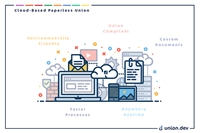15Mar
Low Code Vs. Traditional Code Software - What is Right for You?
15 Mar, 2023
|
software,
union,
tpa,
third party administrator,
benefits administration software,
union management software,
joomla,
Oracle APEX,
SQL,
C# |
Return|
Technology | 6 MIN READ
Low Code Vs. Traditional Development: Which is Right for You?
For Benefit Administrators, Business Managers & Union Trustees
The union industry is quickly moving towards the modern age. As some legacy technologies grow old and start to phase out, so does the aging working population that can support them.
The biggest question we see when selecting a new vendor for union management or benefits administration software is “should we use a low code or traditional code platform?” Albeit we are a bit biased over here, mainly because that Union.dev has invested in highly skilled developers and does not use a low-code platform – We will try and keep the biases to a minimum and show you a high level overview of the pros and cons of using a low code platform versus a traditional code platform.
Low Code Explained
With low-code, non-technical developers don’t have to write code, allowing them to create apps quickly and easily, whereas professional developers benefit from the platforms’ automated, cloud-hosted infrastructure and third-party management. This is great for building solutions to reach the market as quickly as possible – and, moreover, low-code application development enables the production of any type of app, for virtually any type of use case.
Examples of Low Code Platforms
- Oracle APEX
- Microsoft Power Apps
- Mendix
- Joomla (web CMS)
Low Code Pros and Cons
The main advantages of low code include:
- Speed. Non-technical IT programmers can build apps faster using a low-code approach because it eliminates some manual programming work. Many low-code platform vendors state that three-quarters of developers who use low-code tools complete projects in under three months, where a traditional approach can take twice as long or more.
- Cost. Because low-code development is faster, it may reduce total costs for the business.
But low code is also subject to several potential disadvantages:
- Quality. Low-code apps may not perform as well or be as reliable as well-designed apps created using a traditional approach. Their auto-generated code is typically designed to support a wide variety of platforms and use cases, rather than a team's specific deployment environment or application architecture.
- Customization. Low-code platforms offer less opportunity to customize an overall application or control how it runs.
- Deployment options. Some low-code platforms allow developers to deploy applications only to certain platforms, such as specific clouds.
- Reuse. Many Low-code modules are restricted to the same low-code platform. If you use Oracle, you may be restricted to Oracle for the entirety of the project.
Traditional Code Explained
The traditional programming method refers to working with an entire team of developers and programmers to gather specific requirements, develop a plan, and work with a development team to create custom code to meet the specific needs of an application. These processes are usually complex, expensive and more time consuming. There also requires a continuous maintenance cycle by the developer to keep the custom software application secure and up to date. If done correctly, the software can continue to evolve and grow with your organization.
Examples of Traditional Code Languages
- Java
- Python
- SQL
- C#
- C++
Traditional Development Pros and Cons
Traditional development offers several advantages:
- Control. Developers have the greatest degree of control over how their code is written and how applications are structured.
- Flexibility. Traditional development can be accomplished using virtually any programming language and development platform.
- Deploy anywhere. Software developed using a traditional approach can be deployed to whichever destinations developers choose to support. If one database becomes obsolete or a better option becomes available, it is possible to switch.
- Customization. If you can explain it, they can build it. There are no constraints in which you have to work in or are limited by. Unlimited customization and feature creation potential exist with traditional development.
There are two drawbacks of traditional development:
- Time. Manual programming is more time-consuming than auto-generated code from low-code tools. It also takes longer to manually tweak code to support multiple platforms and build sockets and other interfaces between applications and services.
- Cost/Skill. Traditional development may require more specialized expertise with a certain programming language or development platform. Special Skills always cost more, meaning you need to pay a premium for developers.
Use Cases for Low Code vs. Traditional Development
Low code can offer a great quick fix to your issues, here are some examples where it can help.
- Integrations. Low-code tools can make it easier to integrate an app that you build with external tools or platforms.
- Simple websites. Easy to build and quick to market/
- Business analytics. A low-code approach is often used to build simple dashboards or reporting tools for analytics.
- Business processes. If your program is being built to support simple processes or workflows that don’t need to be customized too much, low code solutions can be easy to build even for people who aren't professional coders.
When to Avoid Low Code
Low code can be a great fit, especially for non-technical organizations that want to build their own programs in house. But here are some reasons why low code may not be the answer for you.
- Security. Low-code is not inherently insecure, but it can be difficult to ensure that low-code software is developed according to strict security standards. Auditing this software is inherently more difficult given the nature of the build.
- Performance. Low-code apps are unlikely to deliver the highest degree of performance. If you want high performance, you may need to optimize every line of code. This is where traditional development is a must have. But you will pay a premium.
- Maintenance. If the low-code tools used to develop your software is discontinued by their vendor, maintenance over the long-term becomes a challenge. We are seeing this a ton on the union space, many AS400s and Oracle legacy systems are becoming obsolete, and organizations are left scrambling.
- Commitment. A dependence on low-code usually puts developers at higher risk of being locked into a particular low-code platform and its ecosystem. They may be able to deploy only to the environments supported by the platform, or encounter difficulties to migrate their codebase to a different vendor's platform. Again, this is very prevalent across the industry right now.
Final Thoughts
The right solution for your organization will typically be one or the other, or a mix of both. At Union.dev we are building a premium platform that is feature rich and caters to all of your current and future needs. Wea are building an ever-evolving platform that will keep up with changing technology. Great for the union or TPA who knows what they want, how they want it, and aren’t in a pinch to get something implemented as soon as possible.
On the flip side, if you find yourself in a situation where time is of the essence, you may want to explore a low code option to get something out there as quickly as possible. Just be weary of the decision you make, as you may find yourself in a similar situation down the road as a result.
Check out Union.dev for the worlds most advanced union management and pension administration platform built with advanced code. Get all the tools you need to empower your admins and help the members from wherever they may be.
Related

The world is moving towards a cloud-based, paperless approach.
Read More >

Why every union needs a modern member portal and the great new features they have.
Read More >

Growth of the union is and always will be a primary goal. It facilitates power in your region and gi...
Read More >
Whether you're new to help desk and ticketing software and you’re looking to dive deeper into t...
Read More >

Discover the transformative impact of labor union software on the modern labor force. This article e...
Read More >

Embark on Local 123's transformative journey from archaic systems to cutting-edge efficiency wit...
Read More >